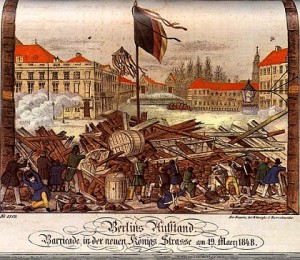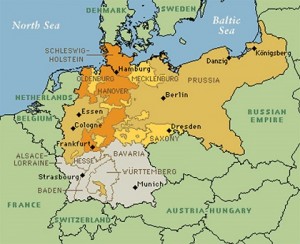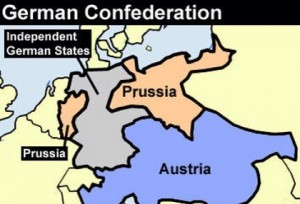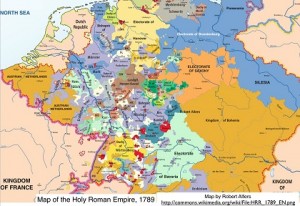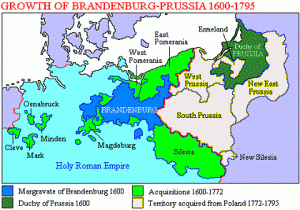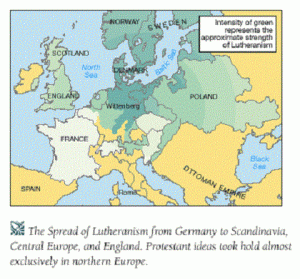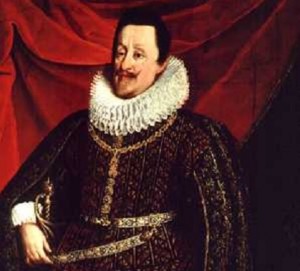Europe endured hard times during much of the 1840s. A series of bad harvests culminating in the potato blight of 1845-46 brought widespread misery and some starvation. An economic depression added to the hardship, spreading discontent among the poor and the middle class alike. A popular uprising in Paris in February 1848 turned into a revolution, … [Read more...]
Economic and Political Trends in Germany Toward Unification
It was not possible for Metternich and his allies to suppress completely the desire for liberal reforms, including the establishment of constitutional parliamentary government, economic freedom, and civil liberties. Some of these reforms had already been under discussion during the eighteenth-century Enlightenment, and awareness of their … [Read more...]
The German Confederation, 1815-66
The Congress of Vienna (1814-15), convened after Napoleon's defeat, sought to restore order in Europe disrupted by revolutionary and imperial France. Its members' objective was a constellation of states and a balance of power that would ensure peace and stability after a quarter-century of revolution and war. In addition to the delegates of many … [Read more...]
The French Revolution and Germany
The French Revolution, which erupted in 1789 with the storming of the Bastille in Paris, at first gained the enthusiastic approval of some German intellectuals, who welcomed the proclamation of a constitution and a bill of rights. Within a few years, most of this support had dissipated, replaced by fear of a newly aggressive French nationalism and … [Read more...]
The Smaller States of Germany: German History
By the eighteenth century, none of the other states of the German empire were strong enough to have territorial ambitions to match those of Prussia and Austria. Some of the larger states, such as Saxony, Bavaria, and Wuerttemberg, also maintained standing armies, but their smaller size compelled them to seek allies, some from outside the empire. … [Read more...]
Austria and Prussia
The most important German power after the Peace of Westphalia was Austria, followed by a few other states with much smaller populations, most notably Brandenburg, Saxony, and Bavaria. Austria retained its preeminence until the second half of the nineteenth century, but in the eighteenth century Brandenburg had become a serious rival, annexing … [Read more...]
The Age of Enlightened Absolutism, 1648-1789
Although the Holy Roman Empire no longer had a significant role in European politics after the Thirty Years' War, it remained important in Germany, providing a framework for the many German states' and cities' conduct of their public affairs. The Reichstag, which remained in session at Regensburg from 1663 until the empire's dissolution in 1806, … [Read more...]
The Peace of Westphalia
The Peace of Westphalia largely settled German affairs for the next century and a half. It ended religious conflicts between the states and included official recognition of Calvinism. Its signatories altered the boundaries of the empire by recognizing that Switzerland and the Netherlands had become sovereign states outside the empire. Portions of … [Read more...]
The Counter-Reformation and Religious Tensions
The Peace of Augsburg brought peace but did not settle the religious disagreements in Germany. For one thing, its signatories did not recognize Calvinism, a relatively stringent form of Protestantism that was gaining prominence around the time the Augsburg treaty was signed, in what has been called the Second Reformation. Adherents to both … [Read more...]
The Thirty Years’ War – Military Campaigns
The Thirty Years' War resulted from a local rebellion, but the admixture of religion transformed it into a European conflict that lasted for more than a generation and devastated Germany. In 1618 Bohemian nobles opposed the decision of Emperor Matthias (r. 1608-19) to designate his Catholic cousin Ferdinand king of Bohemia. Instead, the nobles … [Read more...]
- « Previous Page
- 1
- …
- 6
- 7
- 8
- 9
- 10
- …
- 13
- Next Page »
